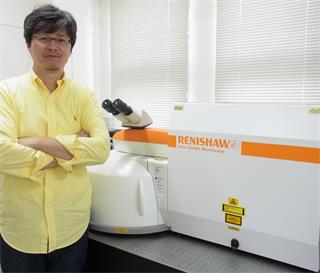Kwansei Gakuin University uses Raman microscopy to study crystallographic defects in silicon carbide wafers
21st August 2015
Kwansei Gakuin University is situated in the Hyogo prefecture in the Japanese cities of Nishinomiya and Sanda. Professor Noboru Ohtani is a member of the Department of Nanotechnology for Sustainable Energy in the School of Science and Technology. His major fields of research are the study of wide band gap semiconductors and crystallographic defects.
Crystallographic defects in 4H-SiC epitaxial wafers, such as dislocations and stacking faults, limit the commercialisation of SiC devices and must therefore be eliminated or reduced to levels lower than some critical density. The department's research goal is to establish SiC crystal growth processes that can produce large, ultra-high quality SiC epitaxial wafers. To achieve this, they try to clarify the cause and formation mechanism of crystallographic defects in SiC bulk crystal and epitaxial film.
Crystallographic defects give rise to residual stresses in the crystals. The stresses can occur through a variety of mechanisms in 4H-SiC crystals. For example, temperature gradients in the grown crystals, which are a primary driving force for crystal growth, lead to plastic deformation of the crystals during the growth and/or cooling process. This deformation results in residual stresses when the crystals are cooled to room temperature. The spatial variation of stresses in the crystals can be measured using Renishaw's inVia confocal Raman microscope. These measurements provide valuable information about the formation of defects during physical vapour transport (PVT) growth and chemical vapour deposition (CVD) processes. This information is used to improve the crystal growth process.
For more images, videos or information on Renishaw and its products, visit our mediahub.
Professor Ohtani's laboratory also uses high resolution X-ray diffraction (HRXRD) to characterise stress distribution. Raman microscopy provides complementary information to the HRXRD data but with much higher spatial resolution. When asked why the inVia was chosen for the lab, Professor Ohtani said: “The key benefit is the ultra-high speed data acquisition system, which results in a higher sensitivity to measuring stresses in the materials compared to other Raman systems.”
Professor Ohtani and his colleagues recently published a paper with the Materials Science Forum describing the ‘structural and electrical characterization of the initial stage of physical vapour transport growth of 4H-SiC crystals.'1 It illustrates the power of micro Raman imaging to help show the influence of heavily-doped nitrogen donors on the defect formation in SiC crystals.
Please visit www.renishaw.com/invia for further details of Renishaw's inVia confocal Raman microscope.
Image: Professor Noboru Ohtani of the Department of Nanotechnology for Sustainable Energy, School of Science and Technology at Kwansei Gakuin University with his Renishaw inVia Raman Microscope.
Reference 1Structural and electrical characterization of the initial stage of physical vapour transport growth of 4H-SiC crystals, Materials Science Forum Vols 821-823 (2015) pp 90-95. www.scientific.net/MSF.821-823.90, T Takahashi et al.
About Renishaw
Renishaw is one of the world's leading engineering and scientific technology companies, with expertise in precision measurement and healthcare. The company supplies products and services used in applications as diverse as jet engine and wind turbine manufacture, through to dentistry and brain surgery. It is also a world leader in the field of additive manufacturing (also referred to as 3D printing), where it is the only UK business that designs and makes industrial machines which ‘print' parts from metal powder.
The Renishaw Group currently has more than 70 offices in 33 countries, with around 4,000 employees, of which 2,600 people are employed within the UK. The majority of the company's R&D and manufacturing is carried out in the UK and for the year ended June 2015 Renishaw achieved sales of £494.7 million of which 95% was due to exports. The company's largest markets are the USA, China, Germany and Japan.
The Company's success has been recognised with numerous international awards, including eighteen Queen's Awards recognising achievements in technology, export and innovation. Renishaw received a Queen's Award for Enterprise 2014, in the Innovations category, for the continuous development of the inVia confocal Raman microscope. For more information visit www.renishaw.com

